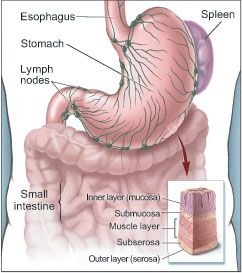When stomach cancer spreads from its original place to another part of the body, the new tumor has the same kind of abnormal cells and the same name as the primary (original) tumor. For example, if stomach cancer spreads to the liver, the cancer cells in the liver are actually stomach cancer cells.
The disease is metastatic stomach cancer, not liver cancer. For that reason, it is treated as stomach cancer, not liver cancer. Doctors call the new tumor "distant" or metastatic disease.
Stages of stomach cancer include:
- Stage 0: The tumor is found only in the inner layer of the stomach. Stage 0 is also called carcinoma in situ.
- Stage I: The tumor is one of the following:
- The tumor has invaded only the submucosa. Cancer cells may be found in up to 2 lymph nodes.
- Or, the tumor has invaded the muscle layer or subserosa. Cancer cells have not spread to lymph nodes or other organs.
- Stage II: The tumor is one of the following:
- The tumor has invaded only the submucosa. Cancer cells have spread to 3 to 15 lymph nodes.
- Or, the tumor has invaded the muscle layer or subserosa. Cancer cells have spread to 1 to 6 lymph nodes.
- Or, the tumor has penetrated the outer layer of the stomach. Cancer cells have not spread to lymph nodes or other organs.
- Stage III: The tumor is one of the following:
- The tumor has invaded the muscle layer or subserosa. Cancer cells have spread to regional lymph nodes.
- Or, the tumor has penetrated the outer layer. Cancer cells have spread to regional lymph nodes.
- Or, the tumor has invaded nearby organs, such as the liver, colon, or spleen. Cancer cells may have spread to 1 to 2 regional lymph nodes.
- Stage IV: Cancer cells have spread to distant organs.
